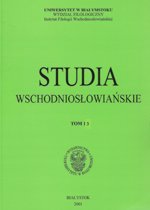Imiona chrzestne w metrykach chrztów parafii rzymsko-katolickiej p.w. św. Jozafata w Korczówce (lata 1928–1938)
Baptismal Names In Baptismal Certificates Of St Jozafat’s Roman Catholic Parish In Korczowka (1928–1938)
Author(s): Anna KuchtaSubject(s): Christian Theology and Religion, Language studies, Geography, Regional studies, Recent History (1900 till today), Historical Linguistics, Western Slavic Languages, Interwar Period (1920 - 1939)
Published by: Wydawnictwo Uniwersytetu w Białymstoku
Keywords: linguistics; onomastics; anthroponymy;
Summary/Abstract: This paper focuses on baptismal names of the inhabitants of Korczowka village from 1928 to 1938.The anthroponymic material was selected from the baptismal certificates of St Jazafat Martyr’s Roman Catholic Parish. The full list of registered names in the investigated certificates allows to state that the majority of names are derived from Christian anthroponymic system. The most popular names of both generations are typical of the culture of the West or belong to a common Catholic and Orthodox set of Christian name giving. One of the characteristic elements of this period is giving the younger generation double names. However, double names are not registered in the baptismal books in the generation of fathers and mothers. It should be emphasized that traditional names were more commonly given to boys rather than girls. It might have been connected with the status of a male offspring in a family. Family tradition was linked to the tradition of giving derived names in many cases. What is interesting, female names were inherited from fathers and male names from mothers. The correlation between the Catholic population and Eastern Slavic tradition in the investigated period is not only indicated by the appearance of common to both religions names. Not only may it be caused by the presence of the nomination of the Orthodox saints’ names, but also by phonetically and graphically transformed name forms e.g. Eugenjusz, Marjan. Such name giving may result from the fact that people could not easily adapt to legal and language changes in a new historical and political situation. The processes occurring in the Catholic name giving from Korczowka and its region in the interwar period (1928–1938) do not differ in their basic principles from the processes in other Christian groups. The derived Christian names co-exist together with native inherited ones. The rule is that rarely given names or the ones not used in the naming system of the older generation, gain more popularity in the younger generation in the diachronic approach (Marjan, Jadwiga – ranked second most popular). The appearance of new, secular or not previously used names results from historical phenomena, social and cultural changes.
Journal: Studia Wschodniosłowiańskie
- Issue Year: 2013
- Issue No: 13
- Page Range: 47-59
- Page Count: 13
- Language: Polish

